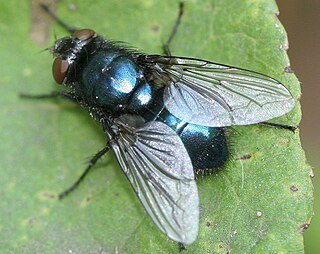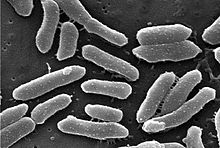Acetobacter is a genus of acetic acid bacteria. Acetic acid bacteria are characterized by the ability to convert ethanol to acetic acid in the presence of oxygen. Of these, the genus Acetobacter is distinguished by the ability to oxidize lactate and acetate into carbon dioxide and water. Bacteria of the genus Acetobacter have been isolated from industrial vinegar fermentation processes and are frequently used as fermentation starter cultures.

Thermus is a genus of thermophilic bacteria. It is one of several bacteria belonging to the Deinococcota phylum. Thermus species can be distinguished from other genera in the family Thermaceae as well as all other bacteria by the presence of eight conserved signature indels (CSIs) found in proteins such as adenylate kinase and replicative DNA helicase as well as 14 conserved signature proteins (CSPs) that are exclusively shared by members of this genus.

Cronobacter is a genus of Gram-negative, facultatively anaerobic, oxidase-negative, catalase-positive, rod-shaped bacteria of the family Enterobacteriaceae. Several Cronobacter species are desiccation resistant and persistent in dry products such as powdered infant formula. They are generally motile, reduce nitrate, use citrate, hydrolyze esculin and arginine, and are positive for L-ornithine decarboxylation. Acid is produced from D-glucose, D-sucrose, D-raffinose, D-melibiose, D-cellobiose, D-mannitol, D-mannose, L-rhamnose, L-arabinose, D-trehalose, galacturonate and D-maltose. Cronobacter spp. are also generally positive for acetoin production and negative for the methyl red test, indicating 2,3-butanediol rather than mixed acid fermentation. The type species of the genus Cronobacter is Cronobacter sakazakii comb. nov.
Agrococcus is a genus in the phylum Actinomycetota (Bacteria).
Agromyces is a genus in the phylum Actinomycetota (Bacteria).
Algoriphagus is a genus in the phylum Bacteroidota (Bacteria).
Providencia rettgeri, is a Gram negative bacterium that is commonly found in both water and land environments. P. rettgeri is in the genus Providencia, along with Providencia stuartii, Providencia alcalifaciens, and Providencia rustigianii. P. rettgeri can be incubated at 37 °C in nutrient agar or nutrient broth. It was first discovered in 1904 after a waterfowl epidemic. Strains of the species have also been isolated from nematodes of the genus Heterorhabditis. Providencia rettgeri also found in marine environment.
Staphylococcus pseudintermedius is a gram positive coccus bacteria of the genus Staphylococcus found worldwide. It is primarily a pathogen for domestic animals, but has been known to affect humans as well. S. pseudintermedius is an opportunistic pathogen that secretes immune modulating virulence factors, has many adhesion factors, and the potential to create biofilms, all of which help to determine the pathogenicity of the bacterium. Diagnoses of Staphylococcus pseudintermedius have traditionally been made using cytology, plating, and biochemical tests. More recently, molecular technologies like MALDI-TOF, DNA hybridization and PCR have become preferred over biochemical tests for their more rapid and accurate identifications. This includes the identification and diagnosis of antibiotic resistant strains.
Psychrobacter is a genus of Gram-negative, osmotolerant, oxidase-positive, psychrophilic or psychrotolerant, aerobic bacteria which belong to the family Moraxellaceae and the class Gammaproteobacteria. The shape is typically cocci or coccobacilli. Some of those bacteria were isolated from humans and can cause humans infections such as endocarditis and peritonitis. This genus of bacteria is able to grow at temperatures between −10 and 42 °C. Rudi Rossau found through DNA-rRNA hybridization analysis that Psychrobacter belongs to the Moraxellaceae. The first species was described by Juni and Heym. Psychrobacter occur in wide range of moist, cold saline habitats, but they also occur in warm and slightly saline habitats.
Psychrobacter phenylpyruvicus is a Gram-negative, catalase- and oxidase-positive, nonmotile bacterium of the genus Psychrobacter, which was isolated from human blood in Belgium. Psychrobacter phenylpyruvicus can cause humans infections such as endocarditis, peritonitis, and fungating lesion of the foot, but those infections caused by this bacterium are rare.
Providencia sneebia is a gram-negative species of bacteria first isolated from the hemolymph of fruit flies. It has also been observed to be symbiotic with marine microalgae. The pathogen has been shown to be fatal to fruit flies without triggering a severe immune response. It has been suggested that P. sneebia is capable of active immune evasion. Thioesterases from P. sneebia have been proposed as industrial enzymes in the production of biofuels.
Citrobacter braakii is a Gram-negative species of bacteria. It has been reported to cause sepsis in an immunocompromised person.
Virgibacillus is a genus of Gram-positive, rod-shaped (bacillus) bacteria and a member of the phylum Bacillota. Virgibacillus species can be obligate aerobes, or facultative anaerobes and catalase enzyme positive. Under stressful environmental conditions, the bacteria can produce oval or ellipsoidal endospores in terminal, or sometimes subterminal, swollen sporangia. The genus was recently reclassified from the genus Bacillus in 1998 following an analysis of the species V. pantothenticus. Subsequently, a number of new species have been discovered or reclassified as Virgibacillus species.
Methylobacterium trifolii is a Gram-negative, aerobic, facultatively methylotrophic and rod-shaped bacteria from the genus of Methylobacterium.
Sphingomonas molluscorum is a Gram-negative, aerobic and non-motile bacteria from the genus of Sphingomonas which has been isolated from the mollusc Anadara broughtonii in the Peter the Great Bay in Russia.
Globicatella sulfidifaciens is a Gram-positive bacteria from the family of Globicatella which has been isolated from the lungs of cattle and lambs in Belgium. It is associated with purulent infections of domestic mammals and urinary tracts of swine. Unlike other Globicatella species and species of related genera, G. sulfidifaciens is PYR negative. Globicatella sulfidifaciens bacteria are resistant against the antibiotics neomycin, erythromycin and clindamycin.
Janibacter is a genus of Gram positive, nonmotile, non-sporeforming bacteria. The genus name is derived from the two-faced Roman god Janus, referring to the fact that the cells of the original strain could be rod-shaped or coccoid.

Diptericin is a 9 kDa antimicrobial peptide (AMP) of flies first isolated from the blowfly Phormia terranova. It is primarily active against Gram-negative bacteria, disrupting bacterial membrane integrity. The structure of this protein includes a proline-rich domain with similarities to the AMPs drosocin, pyrrhocoricin, and abaecin, and a glycine-rich domain with similarity to attacin. Diptericin is an iconic readout of immune system activity in flies, used ubiquitously in studies of Drosophila immunity. Diptericin is named after the insect order Diptera.

The Imd pathway is a broadly-conserved NF-κB immune signalling pathway of insects and some arthropods that regulates a potent antibacterial defence response. The pathway is named after the discovery of a mutation causing severe immune deficiency. The Imd pathway was first discovered in 1995 using Drosophila fruit flies by Bruno Lemaitre and colleagues, who also later discovered that the Drosophila Toll gene regulated defence against Gram-positive bacteria and fungi. Together the Toll and Imd pathways have formed a paradigm of insect immune signalling; as of September 2, 2019, these two landmark discovery papers have been cited collectively over 5000 times since publication on Google Scholar.

The Morganellaceae are a family of Gram-negative bacteria that include some important human pathogens formerly classified as Enterobacteriaceae. This family is a member of the order Enterobacterales in the class Gammaproteobacteria of the phylum Pseudomonadota. Genera in this family include the type genus Morganella, along with Arsenophonus, Cosenzaea, Moellerella, Photorhabdus, Proteus, Providencia and Xenorhabdus.





